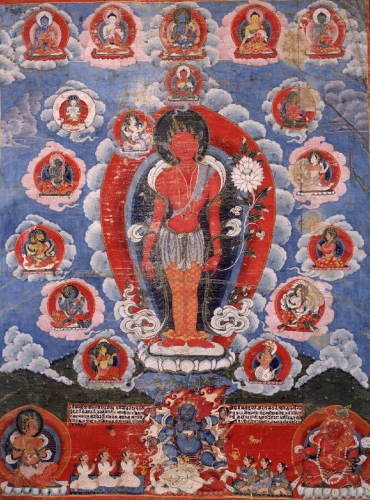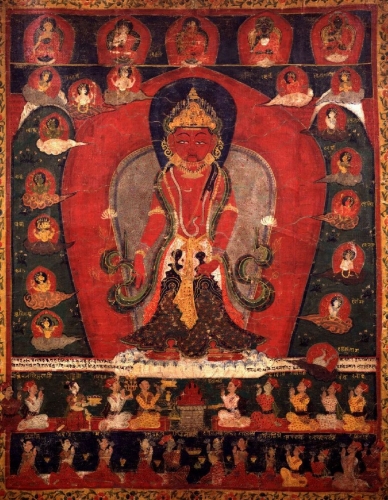Buddhist practice and Buddhist art have been inseparable in the Himalayas ever since Buddhism arrived to the region in the eighth century. But for the casual observer it can be difficult to make sense of the complex iconography. Not to worry—Himalayan art scholar Jeff Watt is here to help. In this “Himalayan Buddhist Art 101” series, Jeff is making sense of this rich artistic tradition by presenting weekly images from the Himalayan Art Resources archives and explaining their roles in the Buddhist tradition.
Who Created the Hindu Gods?

This might seem like a strange question when looking at Buddhist art but it has its place. According to one Mahayana Buddhist text, the Karandavyuha Sutra, at least nine of the well-known Hindu gods are created from the compassionate activity of Avalokiteshvara. The sutra, dating from the 4th or 5th century, was translated from Sanskrit into both Tibetan and Chinese.
The iconography depicting Avalokiteshvara creating the Hindu gods appears in both Nepalese and Tibetan art. Known depictions all follow the same basic iconography and composition, where the central figure is a standing red Avalokiteshvara with one face and two hands. The left hand points downward in a gesture of generosity, holding a flower blossom. The right arm points down in the same gesture, also sometimes holding the stem of a flower blossom. The figure is peaceful and beautiful in appearance, wearing lavish jewelery and heavenly garments. Draped over his left shoulder is the obligatory krishnasara deer skin.

Surrounding the large central figure of Avalokiteshvara are the Hindu gods, emanations originating from specific locations on the body of Avalokiteshvara. In some paintings a ray of light extends outward and the god manifests on a lotus seat; in others it is a trail of white clouds. The resulting composition consists of the large central subject of Avalokiteshvara with many small figures of gods surrounding and framing him.
The Karandavyuha Sutra (Tibetan translation) reads,
From the eyes are the sun [Surya] and moon [Chandra], from the forehead Maheshvara [Shiva], from the shoulder Brahma, from the heart the Great Powerful One [Vishnu], from the teeth the Goddess Sarasvati, from the mouth all of the wind is born [Vayu], from the feet earth [Bhudevi], and from the belly arises the Water God [Varuna].

Although consistent in composition, the paintings vary in their respective iconographies for each of the Hindu gods. Variations include the colors of the gods, the numbers of arms, and the attributes held in the hands. Additional gods are also sometimes added to the original nine mentioned in the sutra. The placement of the gods in the composition can also vary slightly, with some artists, for example, placing Shiva higher in the hierarchy, closer to the head of Avalokiteshvara, and other gods lower.
Regardless of the minor iconographic differences, the overall theme and composition of the paintings is clear and consistent, based in the Karandavyuha Sutra, where Avalokiteshvara is the creator and progenitor of the Hindu Gods.
Learn more about this form of Avalokiteshvara and explore source literature and text references at Himalayan Art Resources, here.
Thank you for subscribing to Tricycle! As a nonprofit, we depend on readers like you to keep Buddhist teachings and practices widely available.